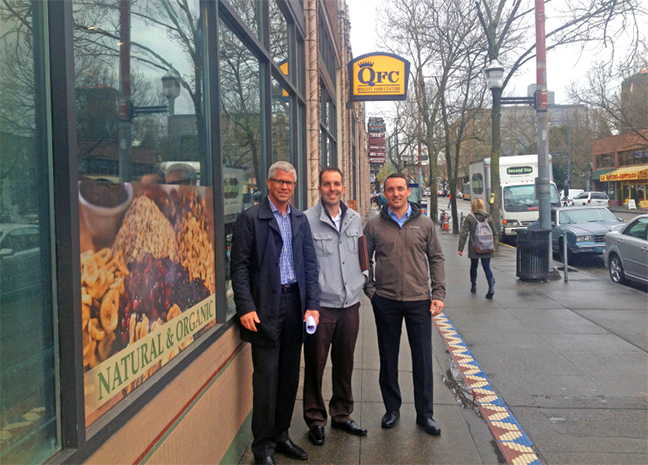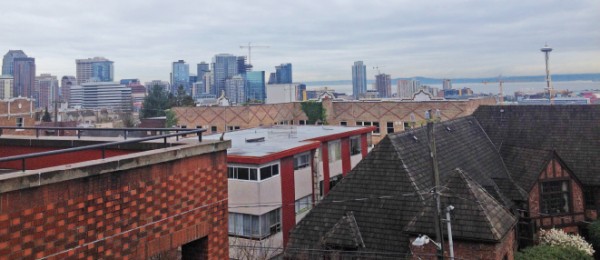What do Nirvana, alcohol advocates, bears, film lovers and Regency Centers have in common? Read on to find out.
Regency Centers' Broadway Market is a 110,000-square-foot urban infill block located less than one mile from downtown Seattle. It’s also entirely indoors. The way the space is used, however, is what sets it apart as it easily has the amount of amenities and merchandising that you might find at any of our larger outdoor centers.
Four of the industry’s finest—Kalin Berger, Regency's senior leasing agent in the Northwest market; Craig Ramey, senior officer for the Northwest; property manager Bret Walton and investments manager Philip Bretsch—and I were recently walking through one of the newest and most unique properties in our portfolio.

Regency Centers' Craig Ramey, Bret Walton and Kalin Berger outside of Seattle's Broadway Market
The property is an accurate reflection of how the consumer base is moving in that market—closer to the city. The millennial generation makes up a large portion of the population in the region, and is a powerful economic force for the future.
Broadway Market reflects the same strategy and structure that Regency is renowned for in the REIT world, just closer to the downtown core of a city. The building is anchored by a Quality Food Center (QFC) and houses a fairly large gym, bank, shoe repair store, clothing store, cell phone center, spa, and credit union. Add in the residential units, and you are looking at a property that fits perfectly with the lifestyles and daily needs of Seattle’s Capitol Hill community.

A lot of work went into evaluating a property of this type in a short amount of time—30 days to be exact. Copious underwriting, due diligence and deferred maintenance issues were addressed to gain ownership of a site that exemplifies Regency’s business model in a community as specific as Capitol Hill. Ramey, along with Laura Clark, Howard Overton and Michael Woods, worked as the team “behind the curtains” to make this Oz a reality for the company.
Before it was the ‘go-to grocery’ center anchored in the middle of the grunge-rock movement, Broadway Market had quite a history. Built in the 1890s, it was originally a row of residential homes before Broadway Street became a major thoroughfare. This is after it was known as a spot to go bear hunting—no kidding. In 1927 it almost became a movie theater. That plan fell through because of a difference in vision with the city and the surrounding properties. Instead, it was turned into a market owned by a developer, a lawyer and a saloon owner. The saloon owner, Henry Beck, was famously known for founding the Knights of the Royal Arch, whose sole purpose was to wage a war on Prohibition. Consider this as you peruse QFC’s expansive wine and spirits section.
Over time the property continued to experience change, for better and worse. There is even a quote from a 1984 Seattle Times article about the importance of the site to the area: “So while Seattle’s Broadway may never be immortalized in verse or song, it certainly can serve as a textbook example of intelligent urban design.”
And it’s true. On the outside, Broadway Market is architecturally classic, yet understated. Upon entering, you are immediately struck by the sheer volume of its contents, the vibrancy of its customers and the vastness of its displays. And instead of exiting to a parking lot, you walk outside to a bustling environment with local dives, eateries, and a Starbucks—it is Seattle, after all.

The view above can never be blocked. It’s taken from one of the penthouse units on the top floor that overlooks the overcast-but-iconic skylines of Seattle. The buildings around the market are protected by historic preservation actions to ensure they won’t have additional stories added. Work is being done to upgrade the interiors of the residential units, new retail tenant possibilities, and meet with other interested parties in order to take advantage of any and all opportunities to ensure Broadway Market’s footprint in the area for years to come.
Seattle is a city that has already established itself as an area of growth and sustainability. The area surrounding Broadway is becoming more of a transit-oriented site between the suburban and downtown areas, and with Amazon hiring a rumored 200-300 people a week for its new headquarters it will only improve the already powerful purchasing potential. Everywhere you look new development is underway, intermixed with the historic and the unique architecture that tells a story of its own—just like Broadway Market.